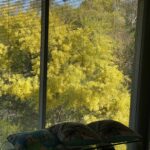Wattles, also called acacias, are wonderful native plants. More than 850 species of wattle grow in Australia, ranging from ground covers and charming shrubs to giant trees that provide fine timber and screening. With this number of species and many cultivars there is a wattle for just about any garden in Australia.
Wattles are tolerant of a broad range of conditions, and they are adapted to cope with hot, dry climates. Most have modified leaves which reduce water loss. Technically these leaves are not true leaves but are leaf-like ‘phyllodes’.
Wattles are fascinating plants for their flower colour and foliage but also for their intimate relationship with ants. Some wattles produce little nectaries at the bases of their leaves. These provide food for ants. Other wattles produce food on their seeds, so that ants collect the seeds to eat the food and so spread the seeds around, thus propagating and spreading the wattle.
Growing wattles
Wattles grow easily from seed. Most wattle seeds can be sown in spring or early autumn into clean plastic pots, seed trays or any plastic container with holes for drainage punched through the bottom. A good potting mix is 1 part washed coarse river sand: 1 part peat moss, or any mix that will re-wet easily, drains well and is coarse enough for good aeration and drainage. To plant seeds simply scatter them over the mix and lightly cover with mix. Once wattle seeds have grown their first true leaves they can be transferred into a tall pot. A cardboard milk container is a good shape for growing wattle seedlings. Fertilising wattles is not generally considered necessary. Mulching should be undertaken to conserve moisture, keep the roots cool, restrict weed growth, reduce soil compaction and improve soil texture. Water only when plants are young or when older plants are showing signs of distress in a very dry period. Regularly tip prune young plants to encourage more compact bushes and prune regularly after flowering, unless seeds are required.
Australia’s floral emblem is Acacia pycnantha. There are some anti-weed campaigners who would like to have Acacia pycnantha declared a noxious weed. This would give us the rare distinction of being the only country ever on earth to declare its only floral emblem a noxious weed.
As well as Acacia pycnantha, other wattles shown or mentioned were:
Golden Sydney Wattle (Acacia longifolia)
A short trunked tree from 3-6m (10-20′) high which flowers from July-October and is widely available throughout Australia. The flowers are scented and attract insects and birds.
Mt. Morgan Wattle (Acacia podalyriifolia) the leaves of which can appear to be bight silver when the sun is at the right angle.
Acacia suaveolens: a wispy wattle with creamy flowers & silvery green foliage.



